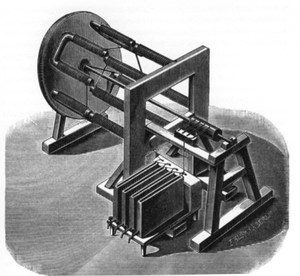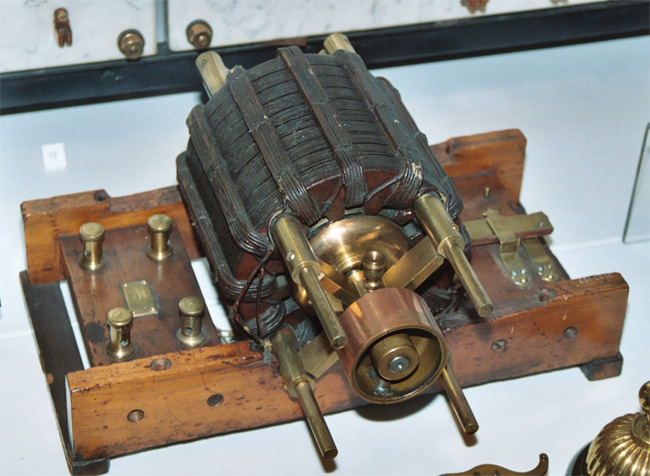
The invention of electric motor marked a pivotal moment in engineering history. An electric motor is a devise that uses electricity to create a mechanical force. There were earlier prototypes to electric motors but they were very weak and more of a spectacle than a working motor capable of producing useful work.
The invention of the electric motor can be said to have first occurred in May 1834 by Moritz Jacobi, although later that year Thomas Davenport independently created an electric motor also. The Jacobi motor was capable of lifting weights of around eleven pounds at a speed of one foot per second – roughly fifteen watts of mechanical power.
Early Contributors and Origins of the Electric Motor
Several inventions and discoveries were essential prior to building an electric motor. As with most modern technological inventions, a synthesis between many ideas developed by different people over a period of time is required. The roots can be traced back to the 19th century when scientists were beginning to understand and unlock the power of electricity.
The history of the invention of the electric motor began with the discovery of electricity itself, thanks to experiments such as Benjamin Franklin’s famous kite experiment. Once this phenomenon was discovered the next steps required a knowledge of storing electricity and then harnessing it to create motion.
The battery, invented by Alessandro Volta in 1799, allowed for the storage of electrical energy and provided a continuous electric current. Then in 1820 Hans Christian Orsted observed for the first time a mechanical movement caused by an electric current. During a lecture he noticed a compass needle was deflected from north when an electric current was nearby. This was an important step in confirming the relationship between electricity and magnetism. Later that year in France Andre Marie Ampere showed that effect could be made stronger by coiling a wire. In 1825 William Sturgeon invented the first electromagnet by wrapping a coil of wires around an iron core.
These experiments and discoveries taken together showed that electricity could be used to produce magnetism. Then, in 1831 Michael Faraday showed the reverse was also true – that magnetism could be used to produce electricity. Faraday’s work on electromagnetic induction in the early 1830s truly laid the foundation for the creation of electric motors. Building on Faraday’s work in the 1830s was the American blacksmith and inventor, Thomas Davenport. He created a small electric motor by using a battery, a magnet, and a wire coil. His creation was one of the earliest practical electric motors and demonstrated the potential for using electricity as a sources of mechanical power.

Thanks to these important discoveries, electric motors began being invented all over the world. Soon other scientists and inventors mad further advancements in electric motor technology. Each motor is designed and works differently but they all use the principles of electromagnetism and the power of the electromagnetic field. By the 1870s and 1880s, practical and efficient electric motors began to be widely developed and used. One of the most notable inventors in this period was Nikola Tesla, who made significant contributions to the development of alternating current (AC) motors. In 1888, he patented a design for a polyphase AC induction motor, which utilized two or more alternating currents out of phase with each other. This design allowed for efficient and reliable conversion of electrical energy into mechanical energy. Tesla’s work revolutionized the field of electrical engineering and played a crucial role in the widespread adoption of electric motors. His inventions and innovations greatly advanced the field of electric motor technology.
Impact on Society
The invention of the electric motor and its subsequent advancements have generated an enormous impact on modern society. Transportation and industrialization have been two been two of the most impacted areas. The electric motor played a crucial role in the industrial revolution, powering machinery and enabling mass production of goods. It eventually replaced steam engines as the dominant from of mechanical power in transportation, paving the way for vehicles such as cars, buses and trains.
More recently, electric motors have found their way into an assortment of household appliances that have becomes essential to modern life. They power refrigerators, washing machines, dishwashers, air conditioners, and many other devices. They are indispensable in renewable energy systems such as wind turbines and hydroelectric generators. Electric motors are at the core of automation and robotics as essential components in conveyor belts, assembly line systems, and other industrial automation applications. The electric motor has had a transformative effect on society, and to this day continues to drive technological advancements.
Continue reading more about the exciting history of science!